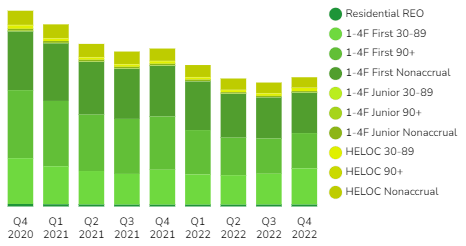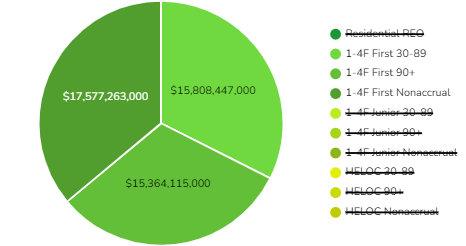
Following two years of improving performance residential mortgage loans appear to have reversed course in Q4 2022, with more newly defaulting loans.
Banks are holding over $40B in distressed residential paper. Last quarter showed some notable upticks in certain non-performing categories, most significantly in late first position loans, followed by nonaccrual stage HELOCs, and REOs.
Much of this is likely being driven by crashing house values, the evaporation of home buyers in the market, and other types of financial distress catching up with borrowers.
There are more than 3x as many late loans and in later stages of defaults as are being classified as REOs.
Let’s dive into the latest bank data from Q4 to see exactly what is going on…
Almost $16B First Position Residential Mortgages Fall Late
There are currently just under $16B in first mortgages on 1-4 family properties which are in the 30-89 day late stage. That’s up by about $2.5B from the previous quarter.
Already ahead of those are first position non accrual loans on 1-4 family residences. As well as more than $15B in 90 day plus late loans, which have not been classified as non accrual yet.
Residential REOs
693 banks reported that they held a combined $829M in residential REO at the end of the fourth quarter of this year, continuing the trend in rising REOs over the previous two quarters. Â
This is still a tiny portion of the total volume of distressed residential loans being held by banks though it is an important data point to watch. Once these non-performing assets are not being absorbed by the market, banks can eventually find themselves in more trouble.Â
Ongoing high inflation, soaring interest rates, a drop off in home sales activity, and declining home prices appear to be finally impacting loan performance. Defaults are also rising on other types of consumer debt which could well roll over into this space.Â
Non-Performing Residential Loans
The largest percentage of non-performing residential mortgage loans continue to be in the nonaccrual stage. Though, there are almost as much 90 day late, and newly delinquent loans behind that.Â

As of Q4 the breakdown of non-performing first mortgage liens being reported includes:
- $15.8B in 30-89 day late loans
- $15.4B in 90 day plus late and still accruing loans
- $17.6B in non-accrual loans
Discover the 3,000 plus banks holding these non-performing loans inside BankProspector now.
Junior Liens
At the end of Q4 2022, there were over $5B in nonaccrual stage revolving lines of credit. There was also $1.3B in newly defaulting 30-89 day late HELOCs behind those.
Defaults on revolving credit lines (HELOCs) continue to be significantly higher than on fixed second mortgage liens.
Dive into the BankProspector dashboard to find out which banks are reporting the most distressed residential junior lien loans and HELOCS.
Looking Ahead
The data from Q4 2022 shows the residential loan market reversing course (and two years of improving debt performance).
A wide barrage of financial challenges impacting homeowners and home buyers certainly isn’t helping borrowers.
If nothing changes, it is likely more distress will come. Although there are really very few REOs, that could change if house prices continue to decline and buyers remain on the sidelines.
However, Goldman Sachs at least says that the deepest declines in house prices are behind us, and we should hit the bottom by Summer 2023. They are predicting a total average drop in house values of about 6%.Â
Of course, many investors with a good pulse on the market may not necessarily buy into their predictions.Â
Log in now to see which banks are currently holding the most distressed loan notes…

